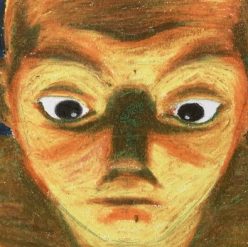I didn’t plan my journey, and the exhibition of Colour accidentally became my first stop. The room of Colour is not big, and the works shown in it all look very simple, only colour blocks and rough paintings, also a piece of abstract sculpture, leading a simple theme: How the use of colour is expanded by modern artists. To be short, it’s the colour experiment.

The most famous work in this room might be IKB 79 by Yves Klein, a painting with nothing else but blue, showing how this artist was obsessed with this colour. But it’s not the only interesting one. I also stood in front of a piece of work of a big, not regular yellow triangle called Yellow Curve (By Ellsworth Kelly) for quite a while, for what’s said in the caption: his yellow triangle doesn’t represent anything other than what it is.


It’s a really interesting concept. In the same room, while I was doing some simple sketches of a waterfall in the forest inspired by another piece of work, which are again very simple, only six blocks in different colours, a man stopped by me.
“Good job.” He said, pointing at the art works on the work. “I’d say your work is more like art than those. It expresses more things.”
I tried to be modest but my thoughts stopped at the word Express. I don’t want to sound arrogant but his words somehow make sense. Why do people create art? To describe? To record? To tell story? All of these answers all leads to one thing: the art is made to mean something. To the audience, I can probably use the word the man said to me, the art expresses things. In that case, when I look back to the yellow triangle, which doesn’t represent anything but a yellow triangle, it doesn’t make sense at all – can something express anything if it only represents itself?
When our ancestors drew an image of ox on the wall of the cave they lived in, they didn’t mean to really express anything either. However, the image of ox doesn’t just represent itself, it also represents that the early stage of how human see the things around them. Or if we ignore the historical factor, the image of ox, still represents the animal ox, or even simpler, the ox, the one that our ancestors saw and decided to draw down. And as the technology developed, people are able to create all those spellbinding images and sculptures out of stories and myths, which I don’t see the necessity to mention whether they represent or express anything or not. But the yellow triangle that doesn’t represent anything but itself, is just a lonely triangle hung on the empty white wall. It doesn’t have any story behind it, it’s not even able to represent other yellow triangles because its creator just wants it to represent itself.
At the same time, I can’t help asking, if a piece of work that doesn’t represent anything but itself and simple as that can be hung in one of the best modern art galleries, is there anything that can’t? Or is the concept of not representing anything but itself the reason why it’s able to be in Tate Modern? And is whether it represent anything something can be decided by the creator? ……
I’ve been to Tate Modern for a lot of times so the whole environment is too familiar for me to notice anything new. The simple white wall, quite confusing structure of building and the deep industrial style everywhere due to the fact that the architecture itself was a factory…… Only walking in it makes me feel like I’m in the new era of art already, plus all the thoughts that came to my mind after this visit, I’m really looking forward to seeing how art is going to develop in the future, with all those new concept, all those possibilities. I hope I’m ready for it.
